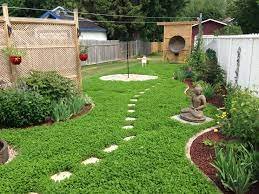In the United States, areas that were once diverse meadows are gradually being converted into turf grass lawns in the style of France and England. At some time in the later half of the 1800s, having a lawn that was well-kept and paid attention to its appearance began to be regarded as a sign of riches.
This style became established in the United States as a result of the invention of the lawnmower and the growing popularity of planned communities designed by landscape architects such as Frederick Law Olmstead, who was responsible for the design of Central Park as well as other well-known parks.
Manicured monocultural lawns may be more aesthetically pleasing, but they come with a number of drawbacks, including a higher water and care bill as well as more chemical treatment than is required for a clover lawn.
These drawbacks are offset, however, by the fact that clover lawns require less treatment overall. Continue reading if you are interested in learning more about clover lawns and determining whether or not they would work well in your yard.
What is Clover Lawn?
Clover lawn is well-known due to the fact that its leaves have the shape of a shamrock, making it a dense ground cover. There is a variety of clover known as white clover that is becoming increasingly popular for lawn cultivation among homeowners. White clover, also known as Dutch clover, is characterized by its dainty white flowers and a disposition toward conditions that are warm and humid.
While some individuals sow clover seeds to hasten the spread of their clover, others simply give up and let it take over the area on its own, which can be a more effective strategy in some cases. In later stages, it requires less attention. On a lawn that used to be brown and uninteresting, there are now stunning white flowers blooming all over the surface.
So why is Clover so trendy right now?
Therefore, why now? “It seems to be following the same pattern as the last twenty years, in my opinion. We are decreasing our dependency on mowers, blowers, and other pieces of machinery while at the same time providing a habitat for pollinators. Because it is an effective strategy for reducing the expenses associated with lawn maintenance, we have decided to use it “according to Teresa Watkins, who established the Sustainable Horticultural Environments organization in Florida.
Additionally, the addition of clover to a lawn makes the grass appear more attractive. “The classic Southern lawn, which is made up of a single variety of grass, gets a bad name because of its monotonous appearance. It’s so last year to have a lawn or garden that only has one type of grass or plants “The Han makes a statement.
Also See: Find Landscaper Near Me
What are the advantages and disadvantages of clover lawn
1. There is no need to water a clover lawn.
Because strawberry clover has deep roots, it has the potential to extract water from the subsoil even when the weather is normal. As a result, the amount of times per week that you have to water your grass will decrease as a result of this. In addition to this, it will keep its green hue even during brief droughts.
2. Grassy areas planted with clover can sustain themselves.
Strawberry clover plants may be able to convert nitrogen in the air into a form that can be utilized as a fertilizer by working in conjunction with bacteria that are capable of fixing nitrogen. It is not necessary to apply any kind of fertilizer to a strawberry clover lawn because the clover itself supplies the nitrogen that is required to maintain the grass healthy and thriving. This will allow you to save money on fertilizer.
3. It doesn’t take long for a clover lawn to take root.
If you simply can’t wait for your emerald carpet to become full and lush, the best option is to plant clover. It won’t be long before you have a lush, green lawn because clover will germinate and start growing in a short amount of time.
4. Clover Lawn are able to flourish even in soil with little fertility.
White clover can grow in acidic soil, despite Watkins’ claim. White clover helps soil by supplying nitrogen. Clover is a legume, says MSSU alum Jay McCurdy. He says nitrogen can be organically absorbed from the soil by legumes and nitrogen-fixing bacteria, therefore synthetic fertilizer is unneeded. If you think of fertilizers as vitamins for your lawn, clover is a nutritious diet, says Watkins.
5. In terms of the environment, Clover Grass is a great choice.
This choice is greener because it doesn’t utilize synthetic fertilizers. If you let clover grow in your lawn, you’ll have more biodiversity and less manmade debris. Clover also helps bees.
6. They are immune to extreme temperatures.
In the Southeast, warm-season plants are employed for lawns (McCurdy). Clover blooms in winter, unlike other grasses that do not. Heat-resistant and durable. Watkins says white clover thrives in full light in USDA Zones 6-9 and beyond. Ask your local farm supply store for more sorts of local clover.
7. Clover Lawn upkeep is minimal.
Put your concerns of finding clover out of your mind. There has already been a considerable amount of labor and time saved. If you plant clover on it, you can reduce the amount of time and money you spend on upkeep tasks like watering and mowing the lawn.
8. You can feel comfortable bringing your pet to play on the clover lawn.
Even after pet urine has discolored and unevenly spread throughout your grass yard, leaving behind yellow microblooms, clover will continue to thrive.
9. The cost of a Clover Lawn is surprisingly low.
In most cases, the cost of purchasing clover seed is less than the cost of purchasing grass seed. Additionally, the cost of lawn maintenance tools, fertilizers, and herbicides is reduced when clover is used.
10. The Clover Lawn is very lovely.
Although the stigma associated with clover flowers needs to be replaced, their beauty, particularly the more delicate white ones, can be quite stunning. However, this may require an adjustment in perception.
Disadvantages of Clover Lawn
1. They can easily be crushed underfoot.
To a certain extent, Clover can tolerate being mistreated, but only up to a certain point. Watkins asks rhetorically if the high school football team that is going to come over to practice on it will be sufficient. This is quite unlikely to be the situation.
2. Sadly, Clover Lawns have a poor reputation.
Even though you may have developed a new perspective on clover, the homeowners association in your neighborhood may not share your excitement. In neighborhoods that have stringent laws against “weeds,” it’s possible that residents won’t be able to have clover lawns.
3. The timing isn’t always good for them.
One of the many charming properties of clover is that it can survive and even flourish in frigid environments. However, due to the fact that grass grows according to an entirely different seasonal schedule, this may prove to be problematic. It’s probable that the clover in your yard, which is green, will stick out more against the brown grass when winter comes around.
The Necessary Information Regarding Clover Grass
Clover lawns require less mowing.
In contrast to grass lawns, which often need to be cut at least once every week, clover lawns typically only need to be trimmed a few times a year at most. Because of this, lawns made with white clover only grow to a height of between 2 and 8 inches.
Mowing the grass in the middle of the growing season is one of the most common ways for homeowners to tidy up their yards and remove wasted blossoms. If you mow your clover grass lawn four to six weeks before the first frost, it will help winterize your lawn, but unlike turf, you won’t need to spend every weekend cutting it like you would if you had turf.
Clover lawns don’t need herbicides or insecticides.
White clover (sometimes called Dutch clover) pushes out weeds with deep roots and quick development, so no herbicides are needed. Avoid using herbicides wherever possible. Clover acts as its own herbicide by outcompeting broadleaf weeds.
Clover attracts pollinators and rabbits, thus pesticides should be avoided to protect them. Broad-spectrum herbicides and pesticides (particularly synthetic pesticides) can impair human, animal, and environmental health.
It doesn’t break the bank to buy clover seed.
White clover seed that is developed specifically for lawns often costs approximately $4 per pound. You should budget for this amount when purchasing the seed. This indicates that the cost of seeding an area that is one thousand square feet might be as low as one dollar. Due to its minimal maintenance requirements in terms of watering, mowing, and insect management, clover lawn seed may be a more cost-effective option to more typical grasses. This is because clover lawns require less watering.
Clover lawns don’t need aeration.
Core aeration is good for turf, but it’s time-consuming and expensive if done by a professional. “Living mulch” clover increases soil health and reduces compaction. Decomposing clover roots create huge soil pores. Earthworms loosen the soil (so it doesn’t need aeration) and reduce thatch.
Clover attracts beneficial insects or bugs.
Clover attracts bees and butterflies. Some of these species are vital to our survival, yet they’re diminishing due to human actions like habitat degradation and pesticide use. If you or your kids go barefoot, a bee may sting you. Microclover blooms less than Dutch white clover; removing grass before flowering will assist. Mowing flowers reduces their value as pollinator food and shelter.
The Various Grass-Friendly Clover Varieties
So, how exactly does clover come into existence? Although there are various variations of clover, they all tend to have an appearance that is rather similar. On each clover stem, there will be three teeny, petal-shaped, white leaves that are either in the shape of a “V” or a crescent. These are the two types of clover that require the least amount of maintenance and look the best in lawns.
White Clover:
The average height of this variety of clover, which in its natural environment is known as Trifolium repens, is typically quite a little greater than that of microclover. This multipurpose plant not only works well as a perennial cover crop, ground cover, and erosion control, but it is also the variety of clover seed that is used most frequently for lawns. Typical clover flowers have the appearance of balls, are white, and emit a sweet fragrance.
Microclover:
In comparison to its more towering sibling, this kind of Dutch white clover has more compact leaves and a lower flower count. It grows at a more leisurely pace, does not cluster together like regular Dutch clover, and is not nearly as invasive as that species.
What You Need to Know About Establishing a Clover Lawn
Even while clover may reseed itself after a few years, it is still beneficial to know how to plant it because you may need to do it every two or three years.
If you want the clover seed to have time to germinate and mature before the advent of cold weather, start planting it in the spring (about the middle of the month). The following are some simple procedures that can be used to develop a lovely clover lawn:
- If you want a lawn full with clover, you’ll need to get rid of the grass first. Seed the clover on top of the grass if you want a more diverse lawn.
- In order to prepare the soil for planting, rake or scratch the surface.
- You should scatter about 6-8 ounces of clover seed per 1,000 square feet. Due to the diminutive size of the seeds, it is important to ensure that they are uniformly dispersed across the entire grass.
- After sowing the clover seeds, spray or water the soil softly on a daily basis until the clover sprouts.
- Do not add fertilizer to your clover grass; it is not needed.



